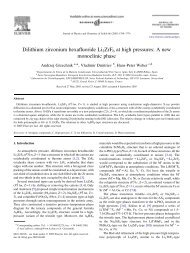Chemical & Engineering News Digital Edition - January 18, 2010
Chemical & Engineering News Digital Edition - January 18, 2010
Chemical & Engineering News Digital Edition - January 18, 2010
You also want an ePaper? Increase the reach of your titles
YUMPU automatically turns print PDFs into web optimized ePapers that Google loves.
newscripts<br />
While navigating his way through<br />
Kentucky a few years back,<br />
Nicholas C. Thomas was surprised<br />
to fi nd two noble gases on his road<br />
atlas. The eastern region of the Bluegrass<br />
State is home to the villages of Krypton<br />
and Neon, about 50 miles apart. Thomas, a<br />
chemistry professor at Auburn University,<br />
in Montgomery, Ala., wondered what other<br />
ELEMENTALLY NAMED HAMLETS might<br />
be scattered about. “I guess I’ve always been<br />
interested in fi nding examples of chemistry<br />
in unusual places,” he tells <strong>News</strong>cripts.<br />
By plugging the elements into the<br />
database of the U.S. Board on Geographic<br />
Names’ website (geonames.usgs.gov),<br />
Thomas was able to fi nd a wealth of towns<br />
named for various elements. “Gold,” for example,<br />
appears in the name of some 2,000<br />
locations throughout the country.<br />
Thomas published a sampling of the<br />
elemental towns he discovered, along with<br />
their histories, in the Journal of <strong>Chemical</strong><br />
Education ( 2009, 86, <strong>18</strong>1). “Understanding<br />
the origin behind the naming of these<br />
towns provides students with an interesting<br />
way to connect chemistry with U.S. history<br />
and geography,” he notes.<br />
Travelers to Bryce Canyon National Park<br />
might consider taking a 40-mile detour<br />
north to Antimony, Utah. Although it’s now<br />
a quiet ranching and vacation community,<br />
Antimony was once home to Butch Cassidy.<br />
The town was originally named Coyote<br />
when it was settled by cattle ranchers, but<br />
the discovery of stibnite—Sb 2 S 3 —<br />
eventually led<br />
to an antimonymining<br />
operation<br />
and a new name.<br />
Barium<br />
Springs, N.C.,<br />
was once known<br />
as Poison Springs<br />
because cattle refused<br />
to drink from<br />
the local mineral<br />
pools. That old name might have<br />
come as a shock to customers<br />
of a company known as the<br />
Great Human Repair Shop,<br />
which sold the local waters<br />
as a health tonic throughout<br />
the country and overseas until<br />
the end of World War I.<br />
With a nod toward the<br />
alchemical, Lead, S.D., is home to<br />
the Homestake mine, which was the<br />
largest, deepest, and most productive<br />
RANDY SMITH<br />
OUR TOWN IS ELEMENTAL<br />
THEODORE GRAY<br />
WWW.CEN-ONLINE.ORG 40 JANUARY <strong>18</strong>, <strong>2010</strong><br />
gold mine in the Western Hemisphere until<br />
it was shuttered in 2001. Thomas notes<br />
that you’ll have to suppress your chemical<br />
instincts if you want to fi t in with the locals,<br />
whose pronunciation of the town’s name<br />
rhymes with “seed.”<br />
Blink and you might miss the 1.2-acre<br />
patch of the Show-Me State known as<br />
Lithium. There’s still a sign to indicate the<br />
tiny, now uninhabited Missouri town.<br />
Many of the towns listed in Thomas’<br />
paper derive their names from local mineral<br />
deposits, but the town of Calcium, N.Y.,<br />
is an exception. As it turns out, Thomas<br />
had to be something of a sleuth to learn<br />
how this hamlet of 3,000 residents got its<br />
name. Very little information about Calcium<br />
is readily available, he tells <strong>News</strong>cripts. It<br />
was only when he placed a cold call to the<br />
Calcium Community Church that Thomas<br />
was able to learn the history of the town’s<br />
name from the local pastor.<br />
In the early 1900s, a local resident<br />
named Madison Cooper successfully petitioned<br />
to have the town’s name changed<br />
from Sanford’s Corner. It was a somewhat<br />
extreme move born out of the frustration of<br />
having his mail frequently sent by mistake<br />
to Stanfordville, N.Y. Cooper worked in cold<br />
storage and refrigeration and chose to<br />
name his hometown for the calcium chloride<br />
used in his trade. Also on the plus side<br />
regarding his postal problems: No other<br />
town in the country was named Calcium.<br />
In the course of his investigation,<br />
Thomas got to thinking<br />
Elementville: Boron, Calif.; Carbon,<br />
Ill.; and Sulphur, La.<br />
that it might be fun to take an<br />
elemental road trip—in his<br />
Chevy Cobalt, of course. The<br />
idea, however, was quickly shot<br />
down by his wife.<br />
BETHANY HALFORD wrote this week’s<br />
column. Please send comments and<br />
suggestions to newscripts@acs.org.<br />
MICHAEL HUNTER




